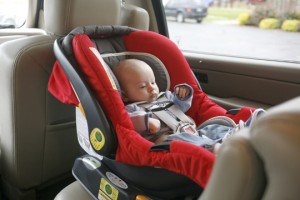Did you know that up to 80% of car seats are used or installed incorrectly? Child Passenger Safety Technician, Brittany, is going to share a few lifesaving tips on how to properly use your car seat and keep your little one safe. Brittany is a Certified Child Passenger Safety Technician, child safety advocate, and passionate about car seat safety.
Using the straps improperly
When a child is rear facing, the straps should be coming from at or below the shoulders. In the event of a car crash, the child is likely going to slide up in their seat and having the straps come from at or below the shoulders is going “lock” the child in their seat and keep them from sliding up. The straps should be threaded through the closest slot to their shoulders that is still coming from behind their back. If the straps are currently coming from above their shoulders, simply unthread the straps at the splitter plate and move them down until they are at the appropriate level
Improper chest clip placement
The chest, or retainer, clip is a pre-crash positioner that is designed to keep the straps on your child’s shoulders in the proper place. When it is placed too high, or more often too low, it can pose an ejection risk to your child. The chest chip should be placed at the armpit level every time your child is in their car seat.
Using aftermarket products
The only products that should be used with your car seat are the items that came with it. It is not recommended to use any aftermarket products for your child’s car seat. This includes head rests, most car seat protectors, and strap covers. Most of these items have not been crash tested, and therefore should not be used. If you feel your child needs additional head support you can roll a receiving blanket on each side of their body (not in a u-shape around their head).
Improper recline/napping on the floor
A car seat is designed to be secured in two places: the car and the stroller. If you look on the side of your car seat there is a line that says “This line should be level to the ground.” When car seats are placed on the floor or similar flat surface it puts your child at risk of positional asphyxiation. Babies have very big heads and very little control. When cars seats are placed on the floor it leans the baby too far forward and their heads can tip to their chest kinking their airway causing positional asphyxiation. To add to this, make sure that your car seat is properly reclined when it is installed in your car. Most car seat bases have a recline indicator that make it easy to see if your child’s car seat is at a safe recline level.
Not tightening the straps enough
In a crash, the straps are what are going to keep your child securely in their seat rather than being ejected. The straps should be tight enough that you can’t pinch any slack at their shoulders. Make sure that you pull the slack from around your child’s thighs to ensure your child’s straps don’t have too much slack.

